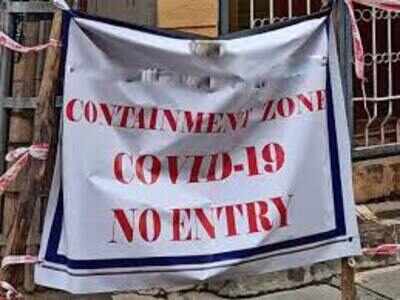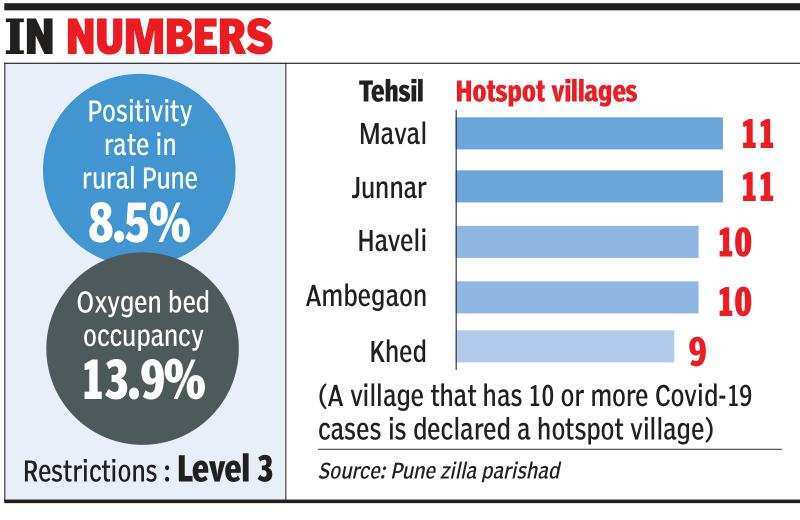Pune: Maval, Junnar tehsils have highest hotspot villages

To be classified as Level 2, rural Pune needs to have a positivity rate of under 5% (file photo)
PUNE: As the district administration ramps up efforts to move rural Pune from Level 3 to Level 2 under the state’s unlock guidelines, the areas under Junnar, Maval, Ambegaon, Haveli and Khed tehsils remain a cause for concern.

More than half the 84 hotspot villages in the rural belt are in these five tehsils. A village with 10 or more active cases is declared a hotspot village. Rural Pune’s weekly positivity rate improved from 9.7% on June 4 to 8.5% on June 16, while the oxygen bed occupancy went down from 19.7% on June 4 to 13.9% on June 16.
To be classified as Level 2, rural Pune needs to have a positivity rate of under 5%.
Pune zilla parishad’s chief executive officer Ayush Prasad said they would also keep an eye out for emerging hotspot villages. “We would continue our strategy of aggressive testing, contact-tracing and early treatment, and strictly enforce social distancing norms across rural Pune in coordination with police and revenue department officials,” Prasad said.
He said there has been a significant improvement in rural Pune’s recovery rate. “Our recovery rate now stands at 96.2%, which is an all-time high. We are more worried about the weekly positivity rate, which, at 8.5%, is higher than both Pune and Pimpri Chinchwad municipal corporations,” Prasad said.
Dr Subhash Salunkhe, advisor to the state government on Covid-19, said the situation in rural Pune was worrisome. “We advised deputy chief minister Ajit Pawar to continue with the prevailing curbs. We might see another spike in cases if people do not follow social distancing norms,” Salunkhe said.
“Right now, many people are gathering and socialising in large numbers; they don’t wear masks. Further, we have an effective public health system and fatigue has set in among healthcare workers who were on Covid duty for more than a year,” Salunkhe added.
District health officer Bhagwan Pawar said over 10,000 rapid antigen test kits have been provided to various tehsil administrations across rural Pune to bolster their testing and surveying efforts.

More than half the 84 hotspot villages in the rural belt are in these five tehsils. A village with 10 or more active cases is declared a hotspot village. Rural Pune’s weekly positivity rate improved from 9.7% on June 4 to 8.5% on June 16, while the oxygen bed occupancy went down from 19.7% on June 4 to 13.9% on June 16.
To be classified as Level 2, rural Pune needs to have a positivity rate of under 5%.
Pune zilla parishad’s chief executive officer Ayush Prasad said they would also keep an eye out for emerging hotspot villages. “We would continue our strategy of aggressive testing, contact-tracing and early treatment, and strictly enforce social distancing norms across rural Pune in coordination with police and revenue department officials,” Prasad said.
He said there has been a significant improvement in rural Pune’s recovery rate. “Our recovery rate now stands at 96.2%, which is an all-time high. We are more worried about the weekly positivity rate, which, at 8.5%, is higher than both Pune and Pimpri Chinchwad municipal corporations,” Prasad said.
Dr Subhash Salunkhe, advisor to the state government on Covid-19, said the situation in rural Pune was worrisome. “We advised deputy chief minister Ajit Pawar to continue with the prevailing curbs. We might see another spike in cases if people do not follow social distancing norms,” Salunkhe said.
“Right now, many people are gathering and socialising in large numbers; they don’t wear masks. Further, we have an effective public health system and fatigue has set in among healthcare workers who were on Covid duty for more than a year,” Salunkhe added.
District health officer Bhagwan Pawar said over 10,000 rapid antigen test kits have been provided to various tehsil administrations across rural Pune to bolster their testing and surveying efforts.
FacebookTwitterLinkedinEMail
Start a Conversation
end of article
Quick Links
Delhi Air PollutionDelhi TemperatureChennai WeatherBangalore TemperatureCovid vaccination centres in DelhiCoronavirus in DelhiRTPCR test in GurgaonHyderabad RainPollution level in BangaloreDelhi SmogDelhi TemperatureNoida AQIGurgaon AQI todayFire in MumbaiMumbai RainsCovid 19 RT PCR Test in NoidaDelhi AQI todaySrinagar encounter
